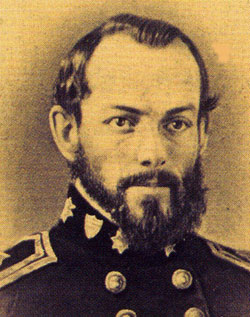In the year 1855 the United States Government set up the 1st and
2nd cavalry units after Jefferson Davis, elected Secretary of War
in 1853, called for their organization. The first US Cavalry was commanded
by Lt. Col. Joseph E. Johnson, who had been a captain of engineers
with Marcy in the 1849 road expedition. The second US Cavalry was
commanded by Col. Albert Sidney Johnson, a graduate of West Point
in 1826. Under his command were 17 officers, who later became generals
during the Civil War. Some of these were Lt. Col. R.E. Lee, Lt. John
Bell Hood, Maj. W.J. Hardy, Capt. Earl Van Dorn, Capt. Edward Kirby
Smith, Lt. Charles W. Field, 1st Lts. Fitzhugh Lee and George H. Thomas
(Rock of Chicamauga) (see story below) , who served as field officer.

General E. Kirby Smith
Center for American History
They were equipped
with Springfield army carbines, movable stocks, and 10" barrels,
and breachloading Perry carbines. There were five 2-company squadrons
armed with navy Colt revolvers and dragoon sabers. This unit left
Jefferson Barracks, Missouri October 27, 1855 with 750 men, 800 horses
and 29 6-mule wagon teams. They crossed the Red River at Preston December
15 during one of the most severe cold spells ever recorded in our
area. When the company arrived at Buffalo Springs on December 22 the
temperature was a minus 4 degrees. On December 24 they marched 20
miles to Flag Springs, 7 miles southwest of Windthorst, where they
remained camped through the 25th (Christmas Day). The temperature
remained constant. On the 26th with temperature at 2 degrees they
marched 20 miles to camp and on the 27th 12 miles to Belknap, where
they camped for several days with temperature of minus 1 degrees.
On January 2 as they proceeded west they discovered a wagon train
with 113 oxen frozen to death. It was January 8 before the temperature
rose, at which time it was 9 degrees. Johnson's wife and baby, as
well as a Negro maid, were on the trip. Mrs. Johnson's diary records
the bad weather. This unit had 55 engagements with the Indians from
January 1856 until February 1861.
This unit's 10 companies had selected horses of like
stature and color for each member of the company. For instance, Van
Dorn's Company was called the "Mobile Grays." A.S. Johnson
rode a fine gray mare. Johnson had been appointed December 13, 1838
as Texas Secretary of War; he called for a mounted ranger force to
be established of 840 men to protect the frontier. Their enlistment
was to be three years at $16 per month with a bounty of $30 for each
Indian scalp, plus a free certificate of land. The total troop was
to be made up of eight companies who could keep some spoils but must
return all stolen merchandise to the settlers. Johnson was made a
Brig. Gen. in 1857 and had patented land in both Palo Pinto and Stephens
Counties in 1855. Reaching Belknap in 1857, 6 companies under Maj.
Enoch Steen were sent to quell the Mormon uprising in Utah. These
included 213 men, 232 horses, 468 mules and 76 wagons. They moved
toward Utah up through Archer County, using the Marcy Trail, crossing
the Little Wichita River at later Van Dorn's Crossing and the Red
River at Steen's Crossing, which was thus named at this time for Major
Steen. The remainder of the second cavalry unit was left to command
the frontier posts of Texas.
The above story is from the book, Trails Through Archer, by
Jack Loftin.
One of our visitors notes:
On the page titled Second Cavalry there is a statement that Joseph
E. Johnson [sic] was the commander of the First US Cavalry. There are
two errors here. The first is a misspelling of the name Johnston (with
a "t"). Your page omits the "t". The second concerns
the command of the First Cavalry. Johnston was never its commander.
At its formation in 1855, Col. Edwin V. Sumner was in command and Johnston
was Sumner's second in command. See http://www.army.mil/cmh-pg/books/R&H/R&H-4CV.htm
Thanks,
Jay Ward
Major George H. Thomas (Rock of Chickamauga)
Maj. George H. Thomas, on an August day in 1860, returning from an extended scout for hostile Indians came across a fresh Indian trail and gave pursuit. Some forty-five miles to the northwest his contingent of the Second Cavalry sighted the Indians, and a chase began.
When the troops were about to overtake the Comanches, an old warrior decided that they would have to be delayed and that he was expendable. He dismounted, probably removed his moccasins as token that he would not leave the place, and as the excited troops dashed up, greeted them with a stream of arrows. Two of the barbed dogwood switches wounded the commander severely, and five troopers were wounded-all with arrows or spear.
Through an interpreter, Thomas tried to get the Comanche to surrender, but the warrior scoffed at the suggestion and taunted the "long knives" to come and get him. At last the troops killed him and found some twenty wounds on his body. With his primitive weapons he had delayed a score or more of well armed troops, permitting his companions to escape.
Major George H. Thomas on Kickapoo Creek
On January 26, 1860 on Kickapoo Creek, Company A of the Second U.S. Cavalry; Major George H. Thomas in command fought the Comanche Indians killing four. |

